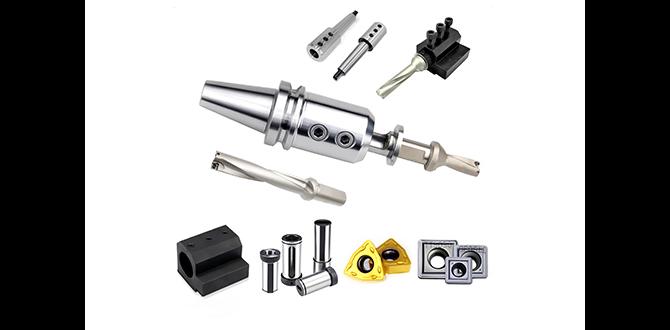Carbide end mills, especially 3/16″ versions, are incredibly effective for cutting PVC. Using the right technique ensures a clean, fast cut every time, minimizing melting and maximizing your workshop efficiency.
Working with plastics like PVC can sometimes feel a bit tricky, especially if you’re new to milling. You might have noticed that some tools can melt the plastic rather than cutting it cleanly, leaving a gummy mess. It’s a common frustration, but the good news is it’s completely solvable! When you need a precise, smooth cut in PVC, a specific type of cutting tool called a carbide end mill, particularly a 3/16-inch one, is your best friend. This guide will walk you through exactly how to use it, turning a potentially messy job into a satisfyingly clean one.
We’ll cover everything from selecting the right end mill to setting up your machine and making those perfect cuts. Get ready to tackle your PVC projects with confidence!
Why a 3/16″ Carbide End Mill is Great for PVC
When it comes to cutting PVC, especially for detailed work or creating specific shapes and grooves, a 3/16-inch carbide end mill offers a fantastic combination of precision and efficiency. Let’s break down why this particular tool shines for this material.
The Magic of Carbide
Carbide, also known as tungsten carbide, is a super hard material made from carbon and tungsten. It’s significantly harder and more brittle than high-speed steel (HSS). This hardness is a game-changer for several reasons when cutting plastics:
- Heat Resistance: Plastics like PVC can get hot quickly when machined, leading to melting and sticking to the cutting tool. Carbide’s superior heat resistance allows it to cut without softening or melting as easily as HSS.
- Edge Retention: Because carbide stays hard at higher temperatures, it keeps its sharp edge much longer. This means consistent cutting performance over time and fewer tool changes for your PVC projects.
- Higher Cutting Speeds: Its hardness also allows for faster cutting speeds and feed rates, which translates to quicker project completion.
The Advantage of the 3/16″ Size
The 3/16-inch diameter is a sweet spot for many PVC applications:
- Precision: This size is small enough for intricate details, fine lines, and precise slots. It’s perfect for creating small features or working in confined spaces.
- Material Removal: While not massive, it’s substantial enough for effective material removal in tasks like pocketing or creating dadoes.
- Versatility: A 3/16-inch end mill is incredibly versatile. It can be used to cut channels, create profiles, or even trim edges with great accuracy.
Why Not Other Tools for PVC?
Trying to cut PVC with the wrong tool can lead to frustrating results:
- Standard Drill Bits: These are designed for making holes, not for clearing material sideways. They can wander, chip, or melt the plastic.
- HSS End Mills: While they can cut PVC, they tend to generate more heat, increasing the risk of melting and gumming up the flutes. They also don’t hold their edge as long as carbide in this application.
- Router Bits: While some router bits can cut PVC, they are designed for different machines and applications. Using them in a milling machine might not yield the same precision or control.
For clean, fast, and precise cuts in PVC, a 3/16-inch carbide end mill is often the top choice for machinists and serious DIYers. It balances detail capability with efficient material removal, and its carbide construction handles the heat generated by plastic exceptionally well.
Choosing Your 3/16″ Carbide End Mill
Not all 3/16″ carbide end mills are created equal, especially when you’re targeting PVC. Understanding a few key features will help you pick the right one for a smooth, efficient cut.
Key Specifications to Look For:
When you’re at the tool supplier or browsing online, keep an eye out for these details:
- Material: As we’ve discussed, 100% solid carbide is ideal. Avoid carbide-tipped tools for fine PVC work, as the brazed joints can be a weak point.
- Number of Flutes: This is crucial for plastics.
- 2-Flute End Mills: These are generally the best choice for plastics like PVC. The extra space between the two flutes (the cutting edges) acts as a chip-carrying chamber. This helps evacuate the melted plastic chips efficiently, preventing them from building up, re-melting, and gumming the tool – a common problem with plastics.
- 3-Flute or 4-Flute End Mills: While great for harder metals, more flutes mean less chip clearance. In plastics, this can aggressively clog the flutes, lead to melting, and cause poor surface finish. Stick to 2-flutes for PVC.
- Coating: For PVC, a coating isn’t usually necessary and can sometimes increase friction and heat. However, if you see specialized coatings designed for plastics (though rare for end mills), they might offer some benefit. Generally, uncoated carbide is perfectly fine and often preferred.
- End Type:
- Square End: This is the most common type and excellent for general-purpose milling, creating slots, pockets, and profiles with sharp internal corners.
- Ball End: Used for creating rounded profiles or 3D contouring. Not typically needed for basic PVC cutting unless you’re doing specific shaping.
- Corner Radius: A square end mill with a small radius on the corners (e.g., 0.010″ or 0.030″) can add a bit of strength to the end mill and leave a slight radius in the bottom of a slot, which can be useful.
For standard PVC cutting, a square end mill is usually the go-to.
- Shank Diameter: The 3/16″ refers to the cutting diameter. Most standard 3/16″ end mills will have a 3/16″, 1/4″, or 3/8″ shank. The shank diameter needs to match your milling machine’s collet or tool holder size for proper grip. A 1/4″ shank is very common and offers good rigidity.
- Length: Standard length is usually sufficient for most PVC cutting tasks. Extended reach tools are typically needed for deeper pockets or reaching into complex geometries, which isn’t common for typical 3/16″ PVC work.
Recommended End Mill for PVC:
The ideal choice for cutting PVC with a 3/16″ diameter end mill would be:
- Material: 100% Solid Carbide
- Flutes: 2
- End Type: Square
- Coating: Uncoated
- Shank: Typically 1/4″ or 3/8″ (ensure it fits your collet system)
- Length: Standard
When you see descriptions like “3/16 inch 1/2 shank standard length for pvc high mrr,” this also points towards a good choice. The “high mrr” hints at a design suitable for higher material removal rates, which is what those two flutes and good carbide enable in plastics.
Essential Machining Setup and Safety
Before you even think about spinning that end mill, a safe and proper setup is paramount. Machining, even plastics, requires respect for the tools and the process. Here’s how to prepare your workspace and machine for success.
Machine Preparation
Your milling machine needs to be ready for the job:
- Cleanliness: Ensure your machine bed, vise, and any fixtures are clean and free of debris. Metal chips or dirt can interfere with a clean hold on your material.
- Vise/Workholding:
- Secure Grip: Use a sturdy vise or appropriate workholding to firmly clamp the PVC. The material must not move at all during the cut. Any slippage can lead to tool breakage or a ruined part.
- Vise Jaws: If possible, use soft jaws or place a thin piece of soft material (like scrap wood or plastic) between the PVC and the vise jaws to prevent marring the surface. Clamp the PVC in the thickest part possible to avoid flex.
- Tool Holder/Collet: Ensure you have the correct size collet for your end mill shank (e.g., if you have a 1/4″ shank end mill, use a 1/4″ collet). A clean collet and collet nut are essential for accurate runout of the tool.
Safety First!
Safety is not optional. Always follow these guidelines:
- Eye Protection: Always wear safety glasses or a face shield. Flying debris, even from plastic, can cause serious eye injury.
- Hearing Protection: Milling machines can be noisy. Wear earplugs or earmuffs.
- No Loose Clothing or Jewelry: These can get caught in moving parts. Tie back long hair.
- Dust Collection: PVC dust can be irritating. While not as hazardous as some other materials, it’s good practice to have dust collection or ventilation.
- Emergency Stop: Know the location of your machine’s emergency stop button and be prepared to use it.
- Keep Hands Clear: Never touch the workpiece, the cutter, or any moving parts of the machine while it is running.
- Tooling Inspection: Before use, visually inspect your end mill for any chips, cracks, or signs of wear. A damaged tool is a safety hazard.
Setting Up the End Mill
Properly installing the end mill is critical for accuracy and safety:
- Clean the Collet: Ensure the collet is clean inside and out.
- Insert End Mill: Push the end mill shank into the collet until it’s seated correctly. Don’t insert it so far that the cutting flutes go past the collet.
- Tighten the Collet Nut: Thread the collet nut onto the spindle housing and tighten it securely using the appropriate wrench. For end mills, it’s crucial that the collet is tightened properly to prevent the tool from being ejected during operation.
- Check Runout: If you have a dial indicator, gently touch it to the end mill shank and spin the spindle by hand. Ideally, you want minimal runout (wobble). Excessive runout can lead to vibration, poor finish, and increased tool wear.
Workpiece Setup
Getting your PVC ready for milling:
- Clamp the PVC: Place your PVC sheet or block securely in the vise. Ensure it’s flat and stable.
- Square the PVC: If you need precise cuts relative to an edge, use a machinist’s square to ensure the PVC is perfectly square to the machine’s axes.
- Set Z-Axis Zero: This is where you tell the machine where the top surface of your material is. Use a Z-axis zeroing tool or a piece of paper slid between the end mill and the material. Carefully lower the end mill until it just touches the surface. Set your Z-axis DRO (Digital Readout) or CNC controller to zero at this point.
Feeds and Speeds for PVC with a 3/16″ Carbide End Mill
This is where the magic happens! Setting the right spindle speed (RPM) and feed rate (how fast the tool moves through the material) is key to getting those clean, melt-free cuts in PVC. For plastics, we generally need higher speeds and slower feed rates compared to metals.
Understanding the Concepts:
- Spindle Speed (RPM): This is how fast the end mill spins. Higher RPMs generally mean faster cutting, but too high can cause melting.
- Feed Rate (IPM or mm/min): This is how fast the cutting tool moves through the material. Too fast a feed can overload the tool or cause chatter. Too slow can lead to rubbing and melting.
- Chip Load: This is the thickness of the chip each flute is removing. A good chip load is essential for efficient cutting and chip evacuation. For plastics, we aim for a slightly lighter chip load than with metals.
General Guidelines for 3/16″ Carbide End Mill in PVC:
These are starting points. You may need to adjust based on your specific machine rigidity, the type of PVC (rigid vs. flexible), and the exact tool geometry.
Important Note: Always start with very conservative settings and gradually increase them as you observe the cut. Listen to your machine – strange noises are often a sign something is wrong.
Recommended Settings Table
| Parameter | Typical Range for 3/16″ Carbide End Mill (2-Flute) in PVC | Notes |
|---|---|---|
| Spindle Speed (RPM) | 10,000 – 20,000 RPM | Higher speeds are generally better for plastics to utilize carbide’s heat resistance and get a clean cut. Start lower and go up. |
| Feed Rate (IPM) | 10 – 30 IPM (approx. 250 – 750 mm/min) | Start on the lower end. Feel the cut. If it’s melting, increase speed or feed. If it’s chattering or the tool is struggling, reduce feed. |
| Chip Load per Flute | 0.001″ – 0.003″ (0.025 – 0.075 mm) | This is a good target for a clean chip. Higher speeds (RPM) and appropriate feed rates help achieve this. |
| Depth of Cut (DOC) – Per Pass | 0.06″ – 0.125″ (1.5 – 3 mm) | For shallow cuts or finishing. |
| Full Depth of Cut (Max) | 0.25″ – 0.5″ (6 – 12 mm) | Only attempt if your machine is very rigid and you are confident. It’s often better to take multiple shallower passes. Always use step-downs. |
| Step-Down (Radial – for pockets) | 0.1″ – 0.180″ (2.5 – 4.5 mm) | Take shallow radial cuts to reduce side load. |
Tips for Achieving High MRR (Material Removal Rate):
To achieve a “high mrr” (Material Removal Rate) with a 3/16″ carbide end mill in PVC, you’re essentially trying to remove material as quickly as possible without causing problems. This is done by:
- Maximizing RPM: Run your spindle as fast as your machine and the tool allow, typically in the higher end of the 10,000-20,000 RPM range.
- Appropriate Feed Rate: Once at high RPM, increase the feed rate until you hear a consistent, crisp cutting sound. If it starts sounding “rubby” or you see melting, the feed rate is too low for that RPM.
- Shallow Axial Depth of Cut (DOC): For the best balance, you want to use shallow passes that engage a good portion of the side of the end mill radially. Instead of taking a deep plunge, take a shallow pass across the surface (e.g., 0.06″ to 0.125″ DOC) at a good feed rate.
- Adequate Radial Step-Down (for Pockets): When hogging out pockets, don’t try to take a full 3/16″ bite at once. Use a radial step-down of about 0.1″ to 0.18″. This engages the 2 flutes efficiently without overloading the tool.
- Good Chip Evacuation: The 2-flute design is key here. Ensure there’s nothing obstructing the flutes. If you’re cutting a deep pocket, consider using a shallow feed rate in the Z-axis to allow chips to clear easily before plunging deeper.
Crucial Considerations:
- Cooling/Lubrication: For PVC, you typically do NOT need coolant. In fact, coolant can sometimes worsen melting issues by not allowing chips to be ejected cleanly. Compressed air is often the best “coolant.” A blast of compressed air directed at the cutting zone will help clear chips and dissipate heat. Check out resources like <a href="https://www.machinerylubricants.




